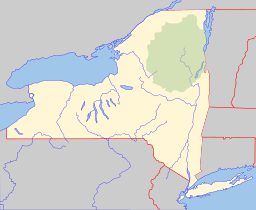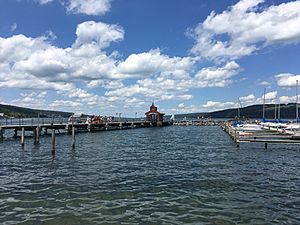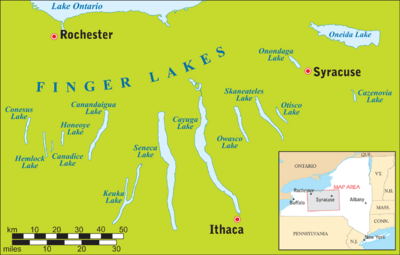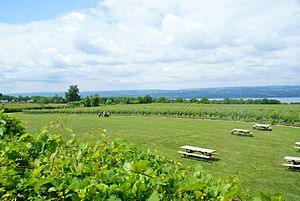Seneca Lake (New York) facts for kids
Quick facts for kids Seneca Lake |
|
|---|---|

Aerial view from the southern part of Seneca Lake.
|
|
| Location | Schuyler, Seneca, Yates, and Ontario counties, New York, United States |
| Group | Finger Lakes |
| Coordinates | 42°39′20″N 76°53′51″W / 42.65556°N 76.89750°W |
| Type | Ground moraine |
| Primary inflows | Catharine Creek, Keuka Lake Outlet, underwater sources |
| Primary outflows | Seneca River/ Cayuga-Seneca Canal |
| Basin countries | United States |
| Max. length | 38 mi (61 km) |
| Surface area | 66.9 sq mi (173 km2) |
| Average depth | 291 ft (89 m) |
| Max. depth | 618 ft (188 m) |
| Water volume | 3.81 cu mi (15.9 km3) |
| Shore length1 | 75.4 miles (121.3 km) |
| Surface elevation | 445 ft (136 m) |
| Settlements | Watkins Glen, Geneva |
| 1 Shore length is not a well-defined measure. | |
Seneca Lake is the biggest of the Finger Lakes in New York State. It is also the deepest lake completely inside the state. Many people call it the "lake trout capital of the world" because of its great fishing. The lake even hosts a big fishing contest called the National Lake Trout Derby.
Because Seneca Lake is so deep and easy to get to, the US Navy uses it. They test special underwater sound equipment, called sonar, here.
The lake gets its name from the Seneca people, a group of Native Americans. At the north end of Seneca Lake is the city of Geneva, New York. This city is home to Hobart and William Smith Colleges and a part of Cornell University that studies farming. At the south end of the lake is the village of Watkins Glen, New York. It is famous for car racing and beautiful waterfalls.
Seneca Lake has a special local climate. This climate helps over 50 wineries grow grapes here. Many of these are small family-run farms. The area is part of a special wine-growing region called the Seneca Lake AVA. You can learn more about it on the Seneca Lake wine trail.
Contents
About Seneca Lake
Seneca Lake is about 38 miles (61 km) long. This makes it the second longest of the Finger Lakes. It also holds the most water, about 3.81 cubic miles (15.9 km3). This is roughly half of all the water in the Finger Lakes combined!
The lake is very deep. Its average depth is 291 feet (89 m). The deepest part is 618 feet (188 m) down. The surface of the lake covers an area of 66.9 square miles (173 km2).
To give you an idea of its size, Scotland's famous Loch Ness is smaller. Loch Ness is 22.5 miles (36.2 km) long and 1.7 miles (2.7 km) wide. It has a surface area of 21.8 square miles (56 km2). Its average depth is 433 feet (132 m), and its deepest point is 744.6 feet (227.0 m). The total water volume of Loch Ness is 1.8 cubic miles (7.5 km3).
Seneca Lake has two main rivers that flow into it. These are Catharine Creek at the south end and the Keuka Lake Outlet. Water flows out of Seneca Lake into the Seneca River. This river is also known as the Cayuga-Seneca Canal. It connects Seneca Lake and Cayuga Lake at their northern ends.
The lake gets water from underground springs. These springs add about 328,000 gallons (1240 m³) of water every minute. The constant flow from these springs keeps the water moving in a circle. This movement means the lake rarely freezes over. Because Seneca Lake is so deep, its temperature stays around 39 °F (4 °C). In summer, the top 10 to 15 feet (3.0 to 4.6 m) can warm up to 70–80 °F (21–27 °C).
Lake Life
Seneca Lake is home to many kinds of fish. In the deeper, colder parts, you can find fish like lake trout and Atlantic salmon. In the shallower, warmer areas, there are fish like smallmouth bass and yellow perch. The lake also has many "sawbellies," which is what locals call alewife shad.
History of Seneca Lake

Seneca Lake was formed a very long time ago, at least two million years ago. Huge glaciers carved out the streams and valleys. Originally, this area had rivers that flowed north. Then, massive glaciers, up to 2 miles thick, moved into the area. This was during the Ice Age. It is believed that the Finger Lakes were created by these glaciers moving forward and backward many times.
Over 200 years ago, Iroquois villages were located on the hills around Seneca Lake. During the American Revolutionary War, these villages faced a difficult time. In 1779, American troops, led by General George Washington, came into their homeland. They destroyed nearly 50 Seneca and Cayuga villages and their crops. Today, roadside signs show the path Sullivan's troops took along the east side of Seneca Lake.
After the war, the Iroquois had to give up their land. Britain had lost the war, and their land was sold. Some of this land was given to soldiers who had fought in the army. Around 1790, European-American settlers began to arrive slowly. At first, these settlers had no easy way to sell their crops. This changed in 1825 when the Erie Canal opened.
The Erie Canal connected the Finger Lakes Region to the rest of the world. Steamships, barges, and ferries quickly became important for trade on Seneca Lake. A shorter canal, the Crooked Lake Canal, also linked Seneca Lake to Keuka Lake.
Many canal barges sank in the lake over the years. A group of these sunken barges near Watkins Glen is now being protected. They are made accessible for scuba diving by the Finger Lakes Underwater Preserve Association.
Fun on the Lake
Fishing
Seneca Lake is a very popular place for fishing. You can catch many different types of fish here. These include lake trout, rainbow trout, brown trout, and landlocked salmon. Other fish found in the lake are largemouth bass, smallmouth bass, northern pike, pickerel, and yellow perch.
Lake Stories and Mysteries
The Seneca Lake Monster
In July 1900, newspapers reported a strange event from July 14, 1899. A steamboat called Otetiani, carrying many passengers, supposedly saw a 25-foot-long "sea monster." It was said to have "two rows of sharp, white teeth." The boat reportedly chased the creature and hit it on purpose. The monster was struck in the middle of its body, breaking its spine. It raised its four-foot-long head, gasped, and then died. The ship tried to pull the monster to shore, but it sank to the bottom of Seneca Lake. Later, a newspaper called the Geneva Gazette suggested the whole story might have been a trick.
Painted Rocks
At the south end of the lake, on the eastern cliff, there are painted rocks. They show an American flag, a Tee-pee, and several Native Americans. Some people thought the older paintings, at the bottom of the cliff, were made in 1779. This was supposedly after the Seneca people escaped from John Sullivan's army.
However, historian Barbara Bell questions this story. She thinks it's unlikely the Seneca people would have returned to paint after escaping. She suggests these paintings might have been made much later for tourists taking boat tours on Seneca Lake.
We do know that the more visible paintings of Native Americans, the American flag, and the Tee-pee were added in 1929. This was for an event celebrating 150 years since Sullivan's campaign. There are two mistakes in these 1929 paintings:
- The Native Americans in the Seneca Region lived in longhouses, not Tee-pees.
- The flag is shown pointing to the left, which is not how it should be displayed on a flat surface.
Seneca Guns
Seneca Lake is also known for strange, loud booming sounds and shakes. These are heard and felt in the area around the lake. Locals call them the Seneca Guns, Lake Drums, or Lake Guns. Similar sounds are known in other places as skyquakes. The name "Lake Guns" came from a short story by James Fenimore Cooper in 1851. No one knows for sure what causes these sounds. It's possible that modern sounds like sonic booms have been mistaken for natural noises.
Military History
The east side of Seneca Lake was once home to a military training area. It was called Sampson Naval Base and was mainly used during World War II. Later, it became Sampson Air Force Base during the Korean War. It was used for basic training for soldiers. After Sampson Air Force Base closed, the airfield remained as Seneca Army Airfield but closed in 2000. The training grounds of Sampson have since become a public park called Sampson State Park.
There is still a Navy facility at Seneca Lake today. It is the Naval Undersea Warfare Center (NUWC) Sonar test facility. A smaller version of the sonar part of the nuclear submarine USS Seawolf (SSN 21) was tested here. This happened while the submarine was being developed. The USS Seawolf was launched in June 1995.
Water Quality Monitoring
There is a special buoy in the northern part of Seneca Lake. It is roughly in the center of the lake. Its exact location is: latitude: 42°41'49.99"N, longitude: 76°55'29.93"W. This buoy has a cellular modem to send information.
The buoy measures many things about the lake and the air. It checks wind speed and direction, how much moisture is in the air, air temperature, and air pressure. It also measures light intensity. For the water, it checks depth, temperature, how well electricity passes through it (conductivity), how cloudy it is (turbidity), and the amount of chlorophyll-a.
The buoy was first placed in the lake in June 2006. The water depth where it is located is about 200 feet (61 m).
Wine Production
Growing grapes and making wine in this area started a long time ago, in the 1800s. The first big winery, the Seneca Lake Wine Company, was founded in 1866. The modern era of wine production began in the 1970s. This was when several new wineries started. It was also helped by a law passed in 1976 called the New York Farm Winery Act of 1976. The region was officially recognized as an American Viticultural Area (a special wine-growing region) in 1988.
The Seneca Lake Wine Trail organizes many events around the lake. One popular event is the annual winter 'Deck the Halls' event. During this event, local wineries show off their different wines.
Transportation
The Elmira & Seneca Lake Railway started operating on June 19, 1900. It ran from Horseheads, New York to Seneca Lake.







